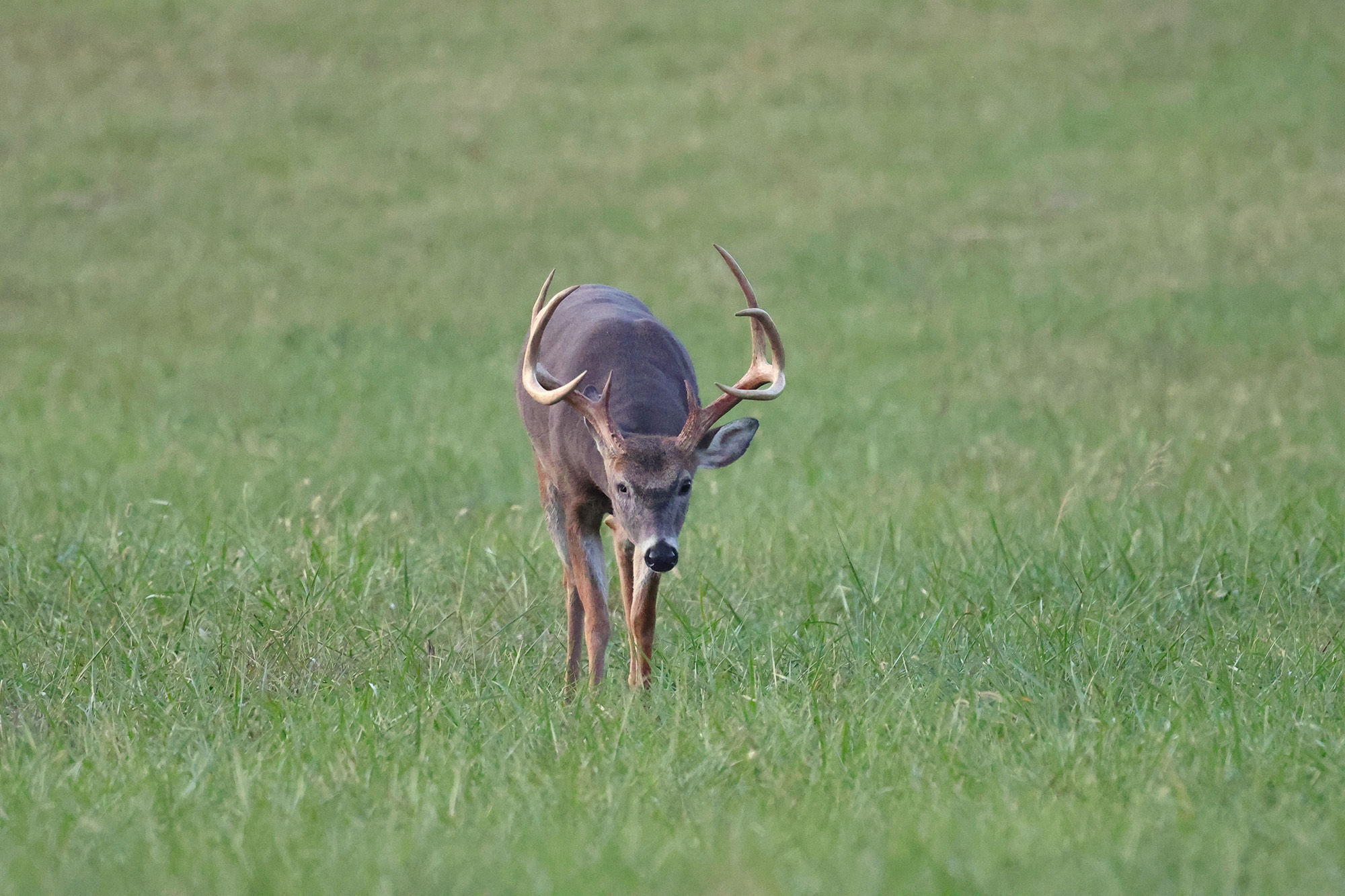10 Odd and Unorthodox Deer Hunting Tips That Actually Do Work

The quintessential private-land deer hunter plants his food plot, hangs his treestand, posts his trail camera, and waits for a daylight pattern on a shooter buck. Meanwhile, the typical public-land hunter scouts his way into a tract of open-to-all ground, finds a stand of productive oak trees, and makes it his go-to spot.
These are what we’d call “orthodox” hunting tips and tactics. These are common approaches that no one really questions. But what about the unorthodox tactics? What about those off-the-wall tips and tactics that seem so far-fetched there is no way they can possibly work? Here are 10 genius deer hunting tips that don’t make much sense (at first glance). But I’ve used nearly all of these tactics with good success, and interviewed many expert whitetail hunters who have as well. We will attest to the fact that they actually work.
Pee in a Scrape (or Mock Scrape)
Hunters have been peeing in Gatorade and Dr. Pepper bottles for generations. For several years, I was among the pee-bottle believers. But many seasons ago, I departed from the group. These days, I don’t carry empty bottles in my backpack. Why? Because human urine doesn’t spook deer. Numerous high-profile deer biologists — including Dr. Kroll — have stated that human urine alone does not spook deer. In fact, deer might even come to investigate it.
With this revelation, hunters started peeing on the ground again. Eventually, they started using their own urine to pee in scrapes or jump-start mock scrapes. Incredibly, it worked.
As someone who freshens a lot of mock scrapes myself, I can attest that human urine can jump-start a mock scrape. I’ve had photos of many bucks visiting and freshening new mock scrapes the same day I visited them. Plus, it’ll save you a few bucks (no need to buy deer urine products) and help you kill one, too. That’s a win-win.
Hunt Fewer Days
Logical thinking would lead you to believe that hunting more days increases your chances of killing a deer. In some situations, that’s true. Think stand locations with great entry and exit routes that offer virtually zero odds of spooking deer that might smell, see, or hear you.
Unfortunately, I’d say almost all tree stand locations don’t offer that scenario. There’s almost always a decent chance of being detected along an entry or exit route to your stand, or in the stand itself.
Because of this, your best chance to kill a mature buck is your first sit. Generally, each sit thereafter offers lower and lower odds of encountering a buck. So, waiting for a high-odds day (like a temperature drop when a buck is on a consistent daylight pattern) and hunting fewer total days can boost your odds of tagging a specific buck.
That said, this rule applies only to early season, pre-rut, post-rut, and late-season deer. I do not restrict my hunting days during the rut.
Hunt on Windy Days
Conventional “wisdom” says that deer don’t move on windy days. Today, we know that’s a myth. Penn State University’s Deer Lab researched the effects of wind on whitetail movements. Studies from 2015, 2016, and 2018 determined that daytime deer movements increased as wind speeds increased. In short, on days with higher wind speeds deer move farther distances during daylight. In contrast, nighttime movements decreased as wind speeds increased.
For hunters, this increased daytime movement is promising. Contrary to what Grandpappy always said, windy days are not days to write off. Quite the opposite, in fact. Windy days are good times to go deer hunting.
Hunt a “Bad” Wind
For decades, people have preached to “hunt the wind,” which means you must keep the wind in your favor, or else. In most instances, I agree with this. It’s always true for entry and exit routes. It’s almost always true for stand locations.
But there’s a time and place for hunting a “bad” wind direction. Some refer to this as hunting a “just-off wind direction.” Others call it hunting a “fringe wind.” Regardless, this is when the wind direction is largely in a buck’s favor, but it’s just off enough that it doesn’t enter your scent cone. This can give a mature buck the confidence to move in a certain direction during daylight.
The Kentucky buck I arrowed this season was a great illustration of this. He almost always walked with a quartering wind, or wind straight up the nostrils. If the wind wasn’t “good” for him and “bad” for my entry routes and stand locations, he didn’t show up. It’s a prime example of how, when bucks get to 4.5 years and older, they learn tricks to evade hunters. Using those same tricks to your advantage is a great way to see and tag a good buck.
On this hunt, I had an east wind. I suspect the buck was bedded about 100 to 120 yards from my stand location. If I’m right, he walked about 80 to 100 yards northward with the wind quartering into him. Then, he likely fish-hooked and walked the next 40 to 50 yards east — with the wind straight up the nostrils. My stand was just offset enough to have about 20 to 30 yards of separation between the edge of my scent cone and his line of travel.
When you learn (and chart) the trail network on a property, and understand how deer navigate it, a “just-off” wind direction hunts become more feasible. Instead of throwing darts at a map and guessing the best times to hunt, you can hunt with a higher degree of confidence that a deer will show up during daylight. Sometimes deer smell you, but sometimes they don’t.
Try a Wind Bump Instead of a Deer Drive
People have been doing deer drives for many years. Usually, that takes several people to push deer in the direction you want them to go, and to cover all escape routes. It’s a lethal tactic that’s resulted in a lot of bucks on the wall and venison in the griddle. (Even the world-record typical Milo Hanson buck was killed this way.) Today, there’s another version of that method. It’s called the “wind bump” and it requires fewer people to execute the play.
First, it requires a firm understanding of the property. To use this effectively, you must know where deer tend to bed and the escape routes they usually use. Then, from afar, have one person leverage the wind direction to subtly push deer from those beds. Another shooter or two should post up to cover the most likely escape paths.
Use the “Bump and Dump” Method
Some bucks move minimal distances during daylight. Some of these same bucks, and others, bed in locations that make them almost impossible to hunt. In these instances, hunters might implement the “bump and dump” strategy, which is one The Hunting Public frequently uses with good results.
This tactic requires a close encounter in which you actually spook the bedded buck. The key is not to let him smell you, or he likely won’t return for a couple days (or longer). Instead, if the buck sees your movement or hears your approach, but can’t completely tell what you are, curiosity just might get the better of him.
More than likely, the deer will jump up and run off just out of sight. After that happens, swing around to the downwind side of the bedding area. Then, hang your stand and settle in; there’s a good chance the buck will return. When he does, expect him to fish-hook in from the downwind side the same day, or possibly the next.
Invade the Bedding Area
Most modern deer hunters advise against hunting in or near bedding areas. Often they encourage hunters to hunt food sources or transition routes between bedding and food. Of course, these are great tactics, but they’re on the more conservative end of the deer-tactics spectrum.
But where do deer spend most of their daytime hours? The answer is within and just outside of bedding areas. Therefore, those of us with limited time to hunt can benefit from hunting the fringes and just inside the edges of bedding areas. This high-risk, high-reward tactic has led to plenty of failures, but a lot of successes, too. The buck I killed this season (see above) was arrowed on the edge of a bedding area.
Sit a Weird Rut Spot
Most of the time, deer bed in obvious, predictable locations. But during the rut, some rules go out the window. For example, mature bucks often push does into oddball locations to get them away from other deer. Doing so decreases likelihood of encountering a rival whitetail, and so, the buck can focus on tending the doe.
Examples of weird rut-hunting spots where bucks often corral does include brush piles, brushy fencerows, sinkholes, (generally) vacant woodlots, spots closer to human inhabitation, and more. Hunting these areas, or at least glassing them from afar, can produce encounters with big deer.
Walk in at Daylight
Generally, hunters walk in and climb into the blind or treestand an hour or more before legal shooting light begins. That said, walking in at daylight might be just as good or better.
Often we spook deer while walking along entry and exit routes in the dark. Even when we don’t realize it, deer detect our presence. Therefore, walking in as shooting light begins, and still-hunting to the treestand can decrease the number of deer you spook. It might also create a shot opportunity.
Use Your Cell Phone to Clear the Field
The afternoon hunt ends, and deer are still milling around. You can’t call someone to drive in and push the deer off with the truck or tractor, then pick you up. You don’t want to climb down and spook the deer, either. Sitting there for two hours until deer leave isn’t an option. So what do you do?
Use your cell phone to clear the field. Start with a good YouTube audio file of an ATV or tractor (whichever deer are used to hearing). Play the audio clip on full blast. After running it for about 20 to 30 seconds, turn on your hunting flashlight. The audio followed by light appearance will simulate an approaching vehicle. This will push deer out of the immediate area and allow you to climb down and depart. It’s much better than deer seeing, hearing, or smelling a human trying to slip out of their stand in the dark.
Final Thoughts on Odball Deer Tactics
As with most things, deer hunting is situational. For example, using one tactic in scenario A would never work, but that same tactic in scenario B can give you excellent odds of success. To that point, the tactics above should be used when it makes sense to do so. Analyze the situation, and then pull the right tactic from your playbook.
Read the full article here







